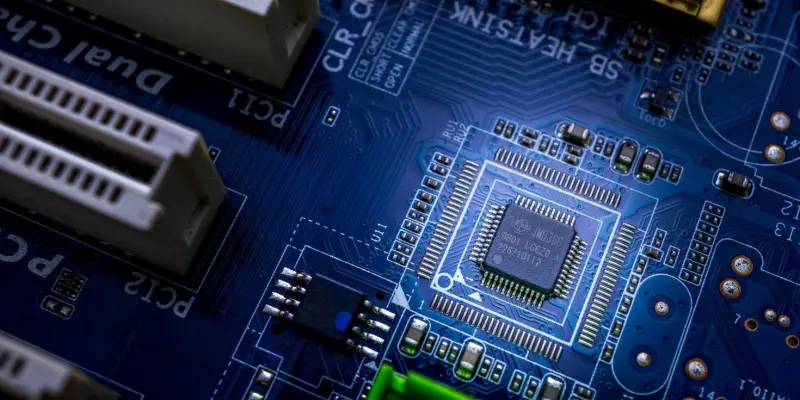In today’s semiconductor landscape, the competition between Taiwan Semiconductor Manufacturing Company (TSMC) and Intel is intensifying. Both companies are advancing their technologies to capture market share amid growing demands for more powerful chips. TSMC has launched its N2, 2nm-class node, securing orders from key players like Apple who have shown an unprecedented demand for this process. This enthusiasm stems from the N2 node’s improved defect density rate, aligning it with TSMC’s previous successes in 3nm and 5nm technologies, and competitively priced wafers around $30,000. TSMC’s strategy involves ramping up production at multiple fabrication plants, beginning with Fab 20 near Baoshan, Taiwan, followed by expansion in Kaohsiung and potentially Fab 21 in Arizona. Meanwhile, Intel is making strides with its sub-2nm 18A node, propelled by their patented PowerVia technology, offering a unique backside power delivery advantage. This distinction has drawn interest from companies like Broadcom and Nvidia, setting the stage for a dynamic shift in semiconductor supplier alliances.
TSMC’s Strategic Expansion
TSMC is aggressively capitalizing on its advanced N2 process to maintain leadership in the semiconductor industry. The company is leveraging its success with past technologies to assure customers of the reliability and efficiency of its latest node, emphasizing its refined defect density rate. This improvement fosters confidence among industry giants like Apple, which are likely to be inaugural customers, and signifies a strong start for TSMC’s newest manufacturing efforts. Pricing is a crucial element in this scenario, as TSMC’s wafers, priced at roughly $30,000, are positioned to compete effectively with similar high-performance chips from other manufacturers. Beyond Taiwan, TSMC’s expansion plans include Fab 21 in Arizona, though possible impacts due to US tariffs need to be considered, which may affect the cost dynamics for US clients. This global production strategy reflects TSMC’s commitment to serving diverse geographic markets while navigating the complexities of international trade regulations to optimize competitiveness.
The logistical execution of such expansive production plans demonstrates TSMC’s approach to managing semiconductor demand worldwide. Starting with Fab 20 in Taiwan, this facility will be integral in increasing output to meet burgeoning orders. As operations gain momentum, additional production capabilities in Kaohsiung are set to become operational, expected by early 2026. This timeline highlights TSMC’s response to industry needs, balancing geographic scales while strategically managing timelines to sustain supply across different regions. Such distribution efforts potentially mitigate risks associated with concentrating production within a single locale, ensuring flexibility to address any unanticipated disruptions. However, the Arizona venture at Fab 21 introduces considerations around pricing variability due to international economic factors, underlining the delicate cost-benefit intricacies as TSMC interacts with both domestic and international players in this fast-evolving technological sphere.
Intel’s Innovative Approach
Intel is similarly making strategic advances in its semiconductor offerings with the introduction of the 18A node, marking a significant step forward due to its sub-2nm classification. Central to Intel’s differentiation is its PowerVia technology, a proprietary system that enhances chip performance through efficient backside power delivery, potentially giving Intel an edge over competitors lacking this feature. As companies like Broadcom and Nvidia evaluate their chip requirements, Intel’s unique technological proposition provides a compelling reason to consider a shift in supplier preference when deciding future semiconductor needs. Competing with TSMC’s gate-all-around transistors, Intel aims to leverage PowerVia to ensure superior energy efficiency and performance benchmarks that might appeal to large-scale electronics manufacturers seeking cutting-edge solutions amid growing consumption demands globally.
Intel’s development achievements extend beyond mere technical innovations to embrace a broader strategic vision under the guidance of its new CEO. The transition indicates a redefined approach to how Intel perceives its role within the semiconductor ecosystem, focusing on enhanced research and collaborations. Risk reduction milestones in the 18A node reflect a conscious shift in Intel’s operational ethos, aiming for not only improved processes but also stronger relationships with end-users and partners across various market segments. This pivot positions Intel as a formidable contender in the chip wars, offering alternatives to companies looking for stable, high-quality components far into the coming years. The blending of unique technologies with revitalized corporate strategies places Intel in an optimal position to secure its ambitions, aiming to balance its traditional market strengths with innovative designs that redefine semiconductor expectations.
Future of Semiconductor Innovation
In the current semiconductor industry, the competition between Taiwan Semiconductor Manufacturing Company (TSMC) and Intel is increasingly fierce. Both are pushing their technologies forward to capture market share, responding to rising demands for advanced chips. TSMC unveiled its N2, 2nm-class node, with Apple securing orders due to a strong demand for this process. This interest is fueled by the N2 node’s enhanced defect density, comparable to TSMC’s earlier success with 3nm and 5nm nodes, and competitively priced wafers at around $30,000. TSMC is ramping up production at various fabs, starting with Fab 20 near Baoshan, Taiwan, followed by expansion in Kaohsiung and possibly Fab 21 in Arizona. On the other hand, Intel is making progress with its sub-2nm 18A node, driven by PowerVia technology offering unique backside power delivery, attracting attention from Broadcom and Nvidia. This sets the stage for a shift in semiconductor supplier alliances, underscoring the dynamic nature of the market.

